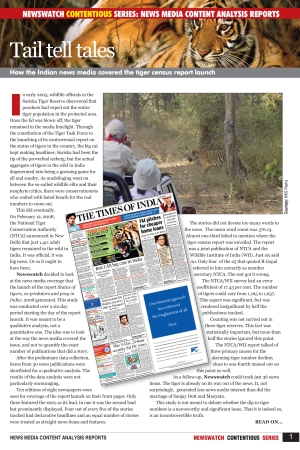In early 2005, wildlife officials in the Sariska Tiger Reserve discovered that poachers had wiped out the entire tiger population in the protected area. Once the lid was blown off, the tiger remained in the media limelight. Through the constitution of the Tiger Task Force to the launching of its controversial report on the status of tigers in the country, the big cat kept making headlines.
Sariska had been the tip of the proverbial iceberg; but the actual aggregate of tigers in the wild in India degenerated into being a guessing game for all and sundry. As mudslinging went on between the so-called wildlife elite and their neophyte critics, there were conservationists who waited with bated breath for the real numbers to come out.
This did eventually. On February 12, 2008, the National Tiger Conservation Authority (NTCA) announced in New Delhi that just 1,411 adult tigers remained in the wild in India. It was official, it was big news. Or so it ought to have been.
Newswatch decided to look at the news media coverage that the launch of the report Status of tigers, co-predators and prey in India: 2008 generated. This study was conducted over a six-day period starting the day of the report launch. It was meant to be a qualitative analysis, not a quantitative one. The idea was to look at the way the news media covered the issue, and not to quantify the exact number of publications that did a story.
After the preliminary data collection, items from 30 news publications were shortlisted for a qualitative analysis. The results of the data analysis were not particularly encouraging.
Ten editions of eight newspapers were seen for coverage of the report launch on their front pages. Only three featured the story as its lead, in one it was the second lead but prominently displayed. Four out of every five of the stories tracked had declarative headlines and an equal number of stories were treated as straight news items and features.
The stories did not devote too many words to the news. The mean word count was 376.13. Almost one-third failed to mention where the tiger census report was unveiled. The report was a joint publication of NTCA and the Wildlife Institute of India (WII). Just six said so. Only four of the 25 that quoted R Gopal referred to him correctly as member secretary NTCA. The rest got it wrong.
The NTCA/WII survey had an error coefficient of 17.43 per cent. The number of tigers could vary from 1,165 to 1,657. This aspect was significant, but was rendered insignificant by half the publications tracked. Counting was not carried out in three tiger reserves. This fact was statistically important, but more than half the stories ignored this point.
The NTCA/WII report talked of three primary causes for the alarming tiger number decline; close to one-fourth missed out on this point as well.
As a follow-up, Newswatch could track just 36 news items. The tiger is already on its way out of the news. It, not surprisingly, generated less news media interest than did the marriage of Sanjay Dutt and Manyata.
This study is not meant to debate whether the dip in tiger numbers is a newsworthy and significant issue. That it is indeed so, is an incontrovertible truth.











